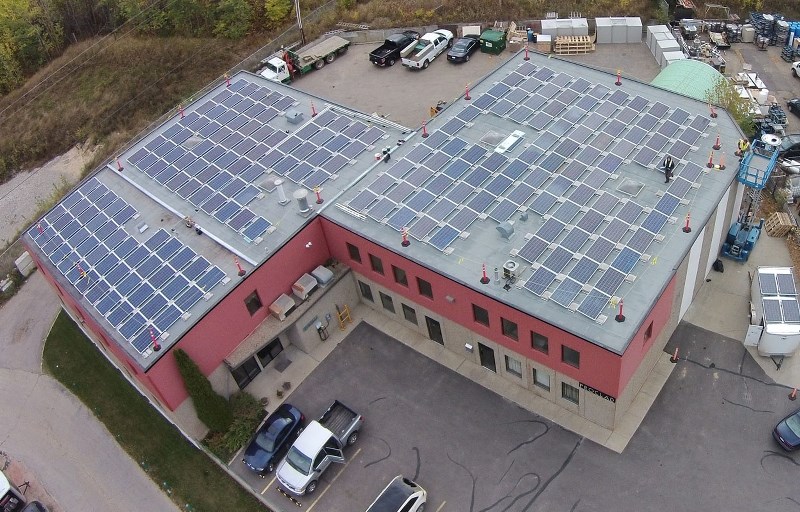Riel Business Park is now host to the biggest solar array in St. Albert thanks to a city construction magnate.
Crews with Edmonton's Great Canadian Solar wrapped up work on a 54-kilowatt, 216-module solar power system atop the Alberco Construction building in the Riel Business Park earlier this month.
The roughly $150,000 system produces enough power to run nine homes or the Alberco office for a year, and should be hooked into the power grid by January, says Clifton Lofthaug, president of Great Canadian Solar and the system's installer.
"It's the largest in St. Albert," he says of the system, and the third largest in the Edmonton region.
Ron Simonsmeier, president of Alberco, says he had been interested in solar power for a number of years before meeting with officials from Enmax Energy at last summer's Drive the Future Expo at the Northern Alberta Institute of Technology. He knew that the Alberco building was well suited for solar – as it had a big, flat roof – and that the price of the panels was falling.
"If something makes economic sense and there's an environmental benefit at the same time, I'm interested in doing it," he says.
Although he mainly got the system to meet his building's power needs, Simonsmeier notes that it will also provide solar power for the electric car charging station he offers on site.
Investment in the future
Alberco is one of the roughly 400 Alberta households and companies that have bought or leased solar panels through Enmax Energy's Home Solar program, says John Rilett, the company's director of distributed generation.
"We want to provide the energy our customers need and we're not too fussy about where it comes from," he says.
The program is meant to reduce the initial capital cost of solar by letting customers pay for panels through a 15-year lease, Rilett says. The Alberco system is part owned, part leased.
"Instead of paying for electricity you purchase from the grid, you're paying for the solar system."
Lofthaug says the system itself took about three weeks to install, with the final connections wrapped up three weeks ago. The toughest part was making it light enough for the roof to support without it being so light that it would blow away in a storm.
"The system itself doesn't penetrate the roof," he notes. Instead, each module is held in place by about five to six pounds of weight per square foot and run through a dedicated electrical panel.
"It should get them close to net-zero electrically," he says.
At 10 cents per kilowatt of power produced, the Alberco system should pay for itself in about 15 years, Lofthaug says. It also comes with a warranty.
The system requires very little maintenance, he continues. You can brush snow off it in the winter if you like, but that yields a mere six to eight per cent increase in performance.
Simonsmeier estimates that his system is currently producing about 25 per cent of its potential output due to the winter sun, but predicts it will do much better in the summer. He estimates that he'll make a five to eight per cent return on the system – a much better rate than he'd get in a bank.
"It's an investment for the future," he says.
"As the price of electricity goes up, my energy costs should stay the same."
Lofthaug says solar essentially locks in your price for power for the foreseeable future, which may be why the solar industry is seeing its greatest growth in the commercial sector right now. It can also net you a tax break – in the form of accelerated depreciation – from the federal government.
"It's really a strategic advantage."
Although you do get some emissions when you make the panels, solar power produces no greenhouse gas emissions or other pollutants while in operation, Rilett says.
Solar is still more expensive than regular power, but definitely pays off over the life of the solar electric system, Rilett says.
"Ron will get his money back and more."
Simonsmeier said any business owner who has a roof that can accommodate panels – ideally a big, flat one – should consider solar power.




